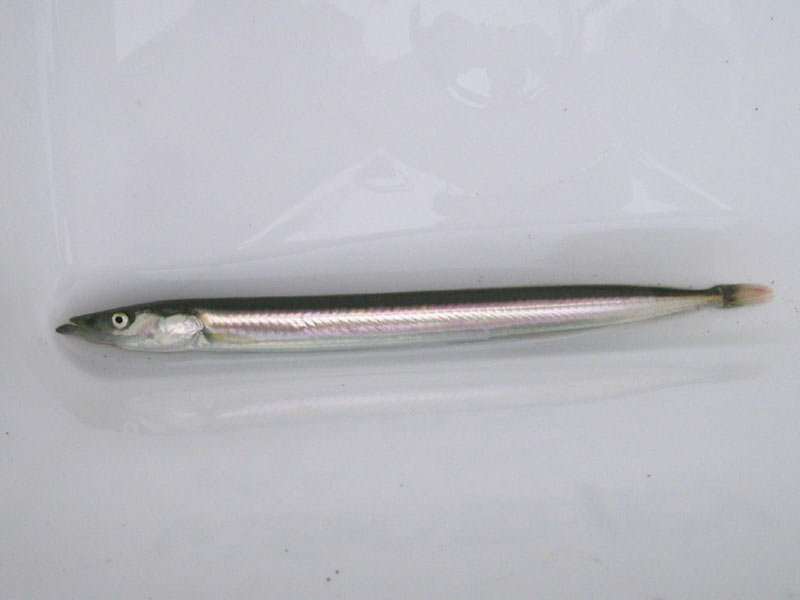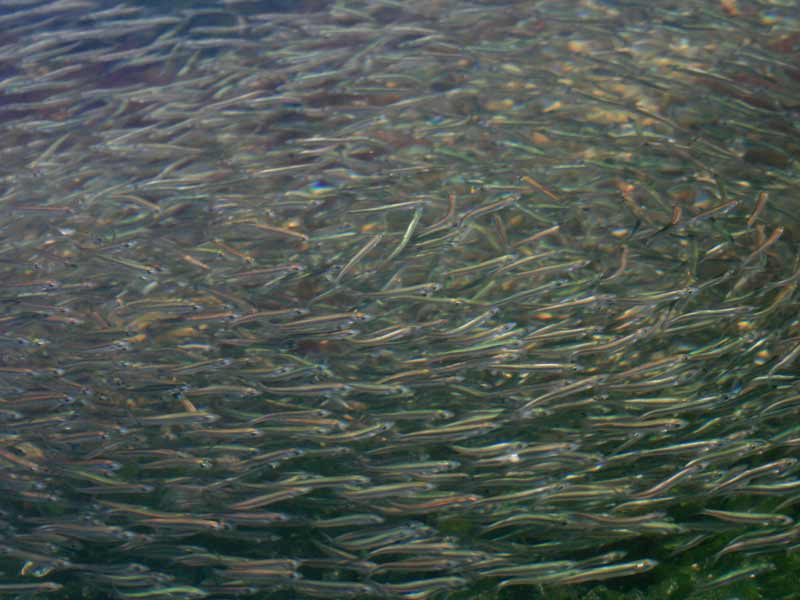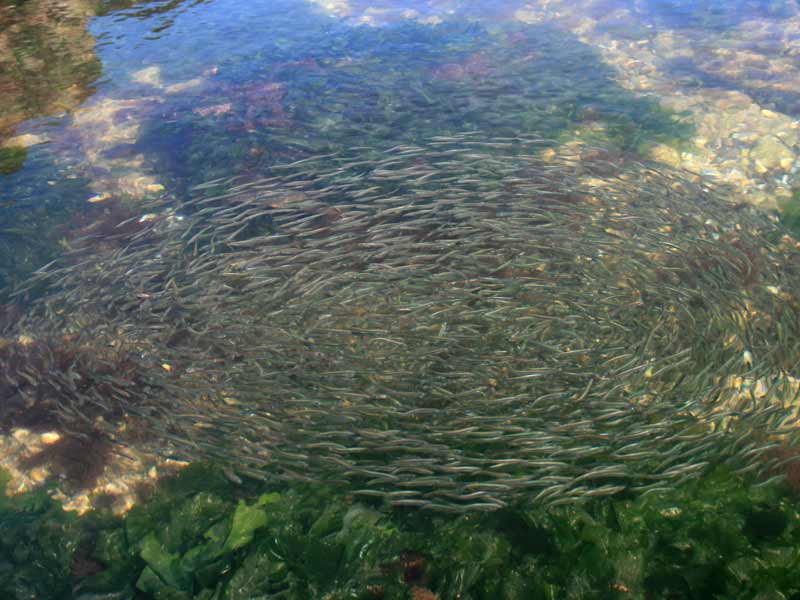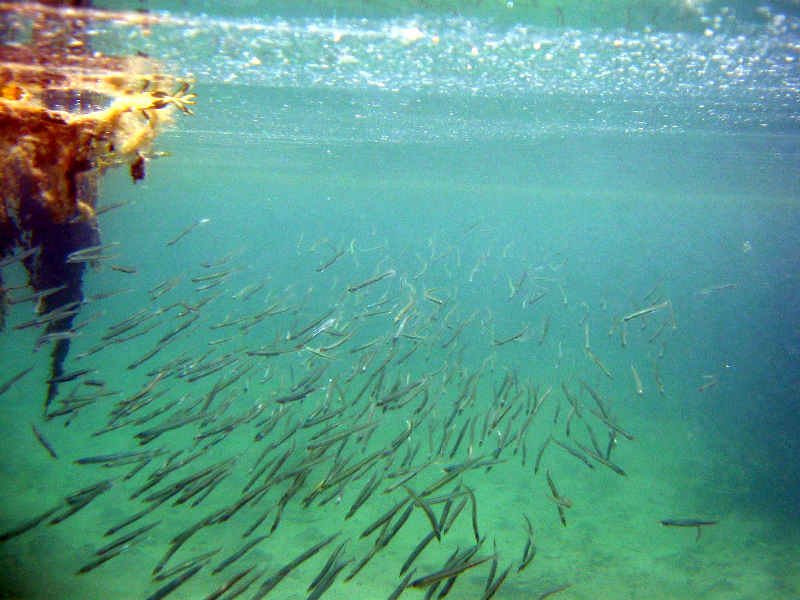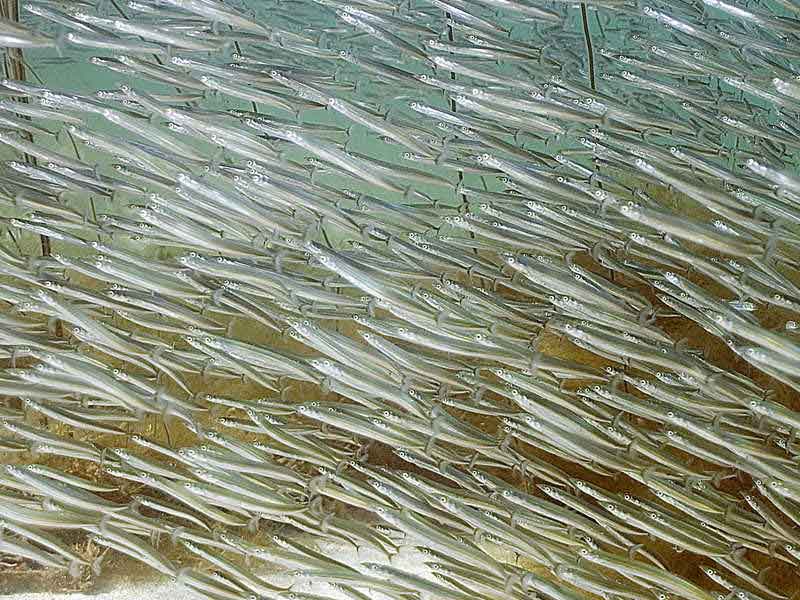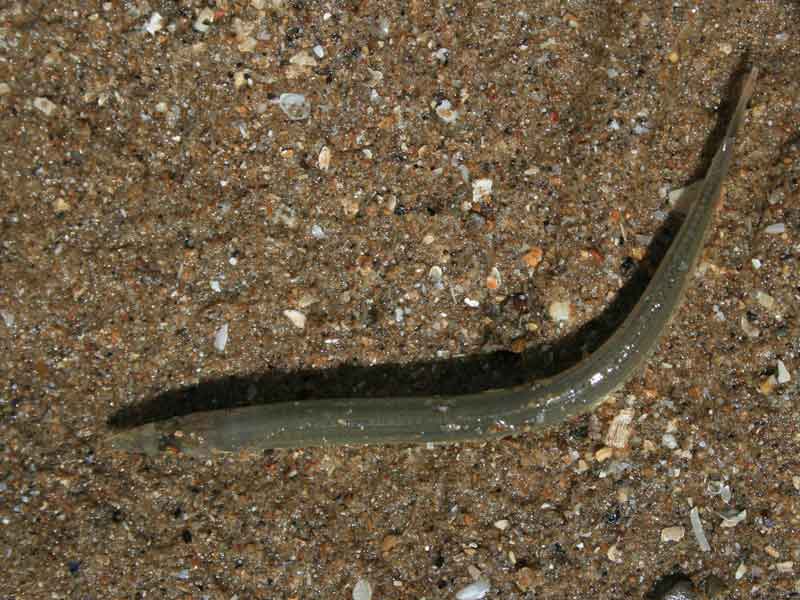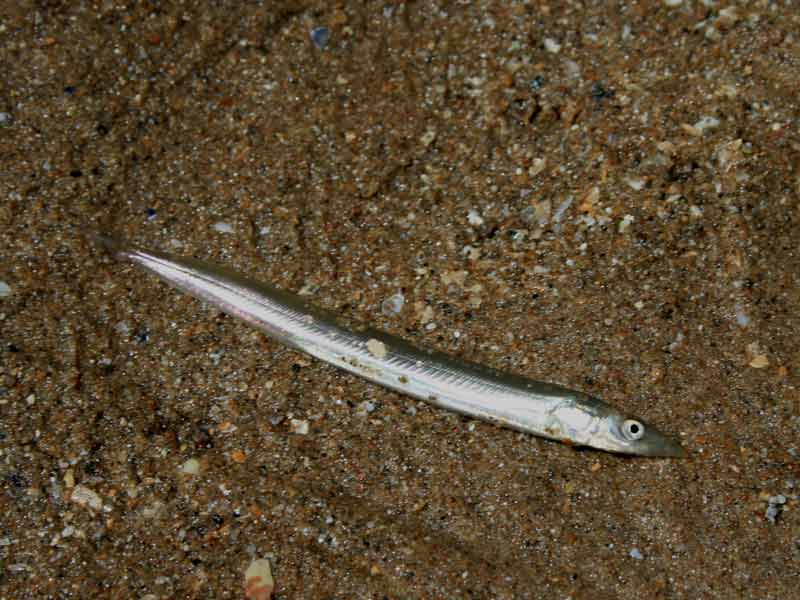Lesser sand eel (Ammodytes tobianus)
Distribution data supplied by the Ocean Biodiversity Information System (OBIS). To interrogate UK data visit the NBN Atlas.Map Help
| Researched by | Sonia Rowley | Refereed by | Admin |
| Authority | Linnaeus, 1758 | ||
| Other common names | - | Synonyms | - |
Summary
Description
The lesser sand eel is long and thin with a pointed jaw and a maximum length of 20 cm. They are yellowish green on the back with occasional bluish tint. The lower sides and belly are silver, giving the fish an overall silvery appearance. Body completely covered in scales, with the scales forming oblique lines of tight chevrons on the underside. There is a single long dorsal fin, and the anal fin is half the length of the dorsal fin. The tail fin is small and distinctively forked. The lower jaw is longer than the upper and there are no teeth in the roof of the mouth.
Recorded distribution in Britain and Ireland
Widely distributed around Britain and Ireland.Global distribution
-Habitat
Found from mid-tide level over sandy shores to the shallow sublittoral to depths of 30 metres. They bury themselves 20-50 cm deep in the sand during the winter.Depth range
-Identifying features
- Elongated narrow body with pointed jaw.
- Forked tail fan.
- Maximum length 20 cm.
- Single long dorsal fin; anal fin half its length.
Additional information
Ammodytes tobianus is the most abundant species of sand eel found in British waters. It has been reported to spawn in spring and summer (Dipper, 2001) or spring and autumn (FishBase, 2000). Eggs are laid in the sand where they adhere to the sand grains. Each female produces 4000-20,000 eggs, which hatch after a few weeks. Their diet consists of zooplankton and some large diatoms as well as worms, small crustaceans and small fish. They swim in schools with heads down and dart into the sand immediately on sign of danger.
Sand eel species are difficult to distinguish underwater (Dipper, 2001). However, if specimens are available, the greater sand eel Hyperoplus lanceolatus can be distinguished from Ammodytes tobianus by presence of teeth in the roof of the mouth and by its inability to protrude its upper jaw. Individuals may reach 7 years of age but 4 years is more common.
Listed by
Bibliography
Dipper, F., 2001. British sea fishes (2nd edn). Teddington: Underwater World Publications Ltd.
FishBase, 2000. FishBase. A global information system on fishes. [On-line] http://www.fishbase.org, 2001-05-03
Hayward, P., Nelson-Smith, T. & Shields, C. 1996. Collins pocket guide. Sea shore of Britain and northern Europe. London: HarperCollins.
Howson, C.M. & Picton, B.E., 1997. The species directory of the marine fauna and flora of the British Isles and surrounding seas. Belfast: Ulster Museum. [Ulster Museum publication, no. 276.]
Wheeler, A., 1969. The fishes of the British Isles and north-west Europe. London: Macmillan.
Whitehead, P.J.P., Bauchot, M.-L., Hureau, J.-C., Nielson, J. & Tortonese, E. 1986. Fishes of the North-eastern Atlantic and the Mediterranean. Vol. I, II & III. Paris: United Nations Educational, Scientific and Cultural Organisation (UNESCO).
Datasets
Centre for Environmental Data and Recording, 2018. Ulster Museum Marine Surveys of Northern Ireland Coastal Waters. Occurrence dataset https://www.nmni.com/CEDaR/CEDaR-Centre-for-Environmental-Data-and-Recording.aspx accessed via NBNAtlas.org on 2018-09-25.
Cofnod – North Wales Environmental Information Service, 2018. Miscellaneous records held on the Cofnod database. Occurrence dataset: https://doi.org/10.15468/hcgqsi accessed via GBIF.org on 2018-09-25.
Environmental Records Information Centre North East, 2018. ERIC NE Combined dataset to 2017. Occurrence dataset: http://www.ericnortheast.org.ukl accessed via NBNAtlas.org on 2018-09-38
Fenwick, 2018. Aphotomarine. Occurrence dataset http://www.aphotomarine.com/index.html Accessed via NBNAtlas.org on 2018-10-01
Fife Nature Records Centre, 2018. St Andrews BioBlitz 2015. Occurrence dataset: https://doi.org/10.15468/xtrbvy accessed via GBIF.org on 2018-09-27.
Isle of Wight Local Records Centre, 2017. IOW Natural History & Archaeological Society Marine Records. Occurrence dataset: https://doi.org/10.15468/7axhcw accessed via GBIF.org on 2018-09-27.
Kent & Medway Biological Records Centre, 2017. Fish: Records for Kent. Occurrence dataset https://doi.org/10.15468/kd1utk accessed via GBIF.org on 2018-09-27.
Manx Biological Recording Partnership, 2017. Isle of Man wildlife records from 01/01/2000 to 13/02/2017. Occurrence dataset: https://doi.org/10.15468/mopwow accessed via GBIF.org on 2018-10-01.
National Trust, 2017. National Trust Species Records. Occurrence dataset: https://doi.org/10.15468/opc6g1 accessed via GBIF.org on 2018-10-01.
NBN (National Biodiversity Network) Atlas. Available from: https://www.nbnatlas.org.
OBIS (Ocean Biodiversity Information System), 2025. Global map of species distribution using gridded data. Available from: Ocean Biogeographic Information System. www.iobis.org. Accessed: 2025-07-30
South East Wales Biodiversity Records Centre, 2018. SEWBReC Fish (South East Wales). Occurrence dataset: https://doi.org/10.15468/htsfiy accessed via GBIF.org on 2018-10-02.
Citation
This review can be cited as:
Last Updated: 08/05/2008
- sand eel
- sandeel

